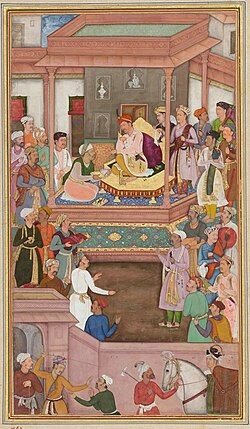Fathullah Shirazi

Fathullah Shirazi (c. 1582), sometimes referred to as Amir Fathullah Shirazi,[1] was a Persian-Indian polymath—a scholar, Islamic jurist, finance minister, mechanical engineer, inventor, mathematician, astronomer, physician, philosopher and artist—who worked for Akbar, ruler of the Mughal Empire. He invented Gaj-I-illahi system .[2][3][4] Shirazi was given the title of 'Azuddudaulah, translated as "the arm of the empire."[5]
Biography
Amir Fathullah Shirazi was a polymath who worked as an imperial finance minister for Akbar. According to Abu'l-Fazl ibn Mubarak's Akbarnama, when Shirazi died, Akbar mourned his death:[3]
[Akbar] grieved at the departure of this memorial of former sages. He often said that the Mir was his vakil, Indian philosophy, physician, and astronomer, and that no one could understand the amount of his grief for him. "Had he fallen into the hands of the Franks, and they had demanded all my treasures in exchange for him, I should gladly have entered into such a profitable traffic, and have bought that precious jewel cheap."
Inventions
Among the inventions credited to him was an early anti-infantry volley gun with multiple gun barrels similar to a hand cannon's.[2]
Another cannon-related machine he created could clean sixteen gun barrels simultaneously, and was operated by a cow.[1] He also developed a seventeen-barrelled cannon fired with a matchlock.[6]
Not all of his creations were intended for warfare, however: he designed a carriage praised by Abu'l-Fazl ibn Mubarak for its comfort. It could also be used to grind corn when not transporting passengers.[1]
Notes
- ^ a b c Friedrich Christian Charles August; Gustav von Buchwald (1890), The Emperor Akbar, Trübner
- ^ a b Bag, A. K. (2005), Fathullah Shirazi: Cannon, Multi-barrel Gun and Yarghu, Indian Journal of History of Science, pp. 431–436.
- ^ a b Richards, John F. (1987), The Mughal Empire, Cambridge University Press, p. 69, ISBN 0-521-56603-7
- ^ Clarence-Smith, William Gervase, Science and technology in early modern Islam, c.1450-c.1850 (PDF), Global Economic History Network, London School of Economics, p. 25
- ^ August, p. 116
- ^ Clarence-Smith, William Gervase, Science and technology in early modern Islam, c.1450-c.1850 (PDF), Global Economic History Network, London School of Economics, p. 7
